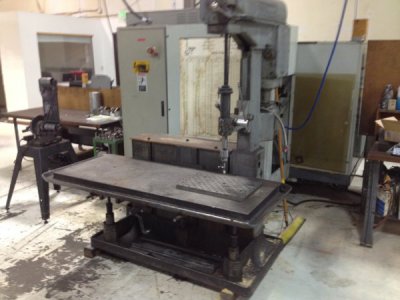B
Buffalo20
Forum Guest
Register Today
I have 4 steel milling machine fixture plates
1 - 12" x 12" x 1/2" with (120) 1/2"-13 threaded holes
1 - 12" x 12" x 1/2" with (100) 3/8"-16 and (110) 1/2"-13 threaded holes
1 - 16" x 16" x 1/2" with (256) 1/2"-13 threaded holes
1 - 16" x 16" x 1/2" with (200) 3/8"-16 and (200) 1/2"-13 threaded holes
These were made up over a few years, for various jobs, while very flat, they were never ground (ungodly expensive). I've used them many times to hold oddly shaped parts. Last week I could have used a bigger one, so I decided to make a larger aluminum one. So the quest for an aluminum plate.
We have one of the largest aluminum plate cutting operation in the state, here locally. I went to see the manager, Mark, saying I was looking for a piece of 5/8" aluminum plate, about 12" x 24" or 16" x 32". There was nothing in the drop section, even close, but there is a job coming in that will yield a piece approximately 16" x 48" x 3/4", that at this point is not earmarked for another order, to be cut to the 16" x 32" size, plus the drop for future use. So that my piece, the plate is to be in next week, with the original order to be out the door by the end of the month, so I should be able to get it around 8/30.
Then the drilling and threading will start, approximately (150) 1/2"13 thread holes in a 2" square grid.
1 - 12" x 12" x 1/2" with (120) 1/2"-13 threaded holes
1 - 12" x 12" x 1/2" with (100) 3/8"-16 and (110) 1/2"-13 threaded holes
1 - 16" x 16" x 1/2" with (256) 1/2"-13 threaded holes
1 - 16" x 16" x 1/2" with (200) 3/8"-16 and (200) 1/2"-13 threaded holes
These were made up over a few years, for various jobs, while very flat, they were never ground (ungodly expensive). I've used them many times to hold oddly shaped parts. Last week I could have used a bigger one, so I decided to make a larger aluminum one. So the quest for an aluminum plate.
We have one of the largest aluminum plate cutting operation in the state, here locally. I went to see the manager, Mark, saying I was looking for a piece of 5/8" aluminum plate, about 12" x 24" or 16" x 32". There was nothing in the drop section, even close, but there is a job coming in that will yield a piece approximately 16" x 48" x 3/4", that at this point is not earmarked for another order, to be cut to the 16" x 32" size, plus the drop for future use. So that my piece, the plate is to be in next week, with the original order to be out the door by the end of the month, so I should be able to get it around 8/30.
Then the drilling and threading will start, approximately (150) 1/2"13 thread holes in a 2" square grid.



